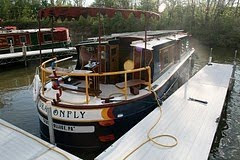 |
| This is our "on-board self-tensioning weight training system" . . . I mean, the lighter of our two anchors |
We had limited experience with anchors before we set out on this trip. OK, the rowboat at the family
camp, up on the lake, had an anchor--specifically, a rock, tied to a rope. You lowered it over
the side, in shallow water, to keep the boat still, so
you could fish.
A rock-on-a-rope is a simple system. You won’t find any “how-to” books, or boating
websites, or weekend classes that teach you how to use it. Granted, a
rock anchor is useless in a gale. But you probably don’t want to fish from a
rowboat in a gale.
Until two nights ago, I thought an anchor functioned to keep you
in one place; I thought the only real consideration was, where to drop it? That’s
how our rock-on-a-rope works. It’s how a nail-in-a-wall works, or any number of other real-world
“anchors.”
Then we anchored Wednesday night in Minim Creek, a narrow tidal river.
To find out what happened, keep reading, below. Click here for a different adventure in anchoring.
Minim Creek is a quiet spot . . . at least, it’s
quiet for a few minutes, four times a day. The rest of the time, millions of
gallons of seawater flow one way, or the other, pulled by the moon. Placing our anchors (we used two) for the night, and retrieving them
the next morning, turned out to be an (ahem) educational adventure.
 |
| Not much protection from the wind on these tidal creeks |
We chose an
anchorage on the lee side of a low, muddy island that supported a few scrawny
trees; we figured they would protect us from the 20-30 mph winds forecast for
later in the night.
We tried to
anchor fore-and-aft (one anchor at the bow of the boat, another at the stern, bow
pointed into the wind) but the current was so strong, we couldn’t get properly
oriented. Finally we dropped two
anchors off the bow, separated by about 100 feet.
The current pushed the boat downstream from both anchors, and it
settled at the point of the “vee,” at a comfortable angle. The boat felt as stable as if it were
tied to a dock on a calm day. We
knew that when the tide changed, the river would change direction, and our boat
would move with the current. We
went to bed feeling smug.
At 3:40 a.m., we felt an unexpected change in the movement of the boat.
It was rocking from side to
side—rocking hard! We put on our
storm gear and headed outside to see what was going on.
The boat had changed position. The wind was howling up from the south; the current
was piling into the creek from the north, and our boat was lying crosswise, at
a 90-degree angle to both wind and current, and rocking in the waves kicked up by
the wind.
We were in a protected spot, so the wind-driven
waves weren’t a hazard. But they were big enough to make us uncomfortable.
Fortunately, the dynamics
were short-lived. Soon, the wind and the water calmed, and we were left to
wonder what we could have done differently. We did take away one lesson: An anchor doesn’t hold you in one place. When
it’s working properly, an anchor lets the boat move. If we'd anchored properly, the boat would have moved into a position that was stable.
In the morning, with scant hours of sleep under our belts, we started
to weigh anchor. But we made an unpleasant discovery. To pull up an anchor, you drive the boat forward till you're directly over it. With the
tension on the line released, the anchor should come up easily.
But our anchors were so far apart from
each other that, with our boat in its new position, shortening one anchor line
didn’t provide enough slack to move up over the other anchor.
I set to work, busily engaged in directing Cynthia at the throttle to move
the boat from side to side, while I did lots of pointless hauling on lines. I was turning
red-faced with the effort of trying make the 14-ton boat move against the
current.
Eventually, Cynthia suggested splicing an extra line onto one of
the anchor lines. That allowed me to pay out enough line that the boat
could ride up over one anchor, and we could pluck it from the bottom. We ran back and plucked up the second anchor. Well done,
mate.
The bottom line: Releasing
an anchor--when there are two of them and the tide is running--is way more
complicated than you might think. Lesson two: When the tide is running, weighing anchor requires more brains than
muscles.
 |
| The view from our anchorage tonight . . . where we're snugly tied, bow and stern, and well protected by big trees. |
So those were our two lessons in anchoring, which naturally made us think
about all of the empty “anchor” stores that we’ve seen in shopping malls this
year. And the shuttered factories
and businesses and schools that we’ve seen in communities hit hard by the
economic downturn.
Maybe when we place anchors made of brick and mortar, we need to think less
like a guy in a rowboat with a rope tied to a rock. We can’t just heave the thing out there and hope it
sticks.
We need to use our brains
as well as our muscles. Winds can
kick up, and the tide can turn. We
should think like a sailor: Will
the anchor let us move? And will it still do its job if conditions change?





No comments:
Post a Comment